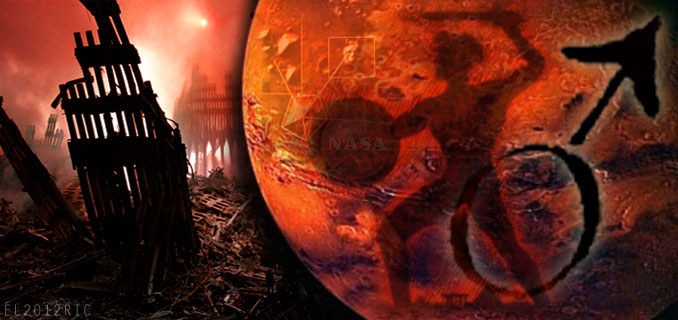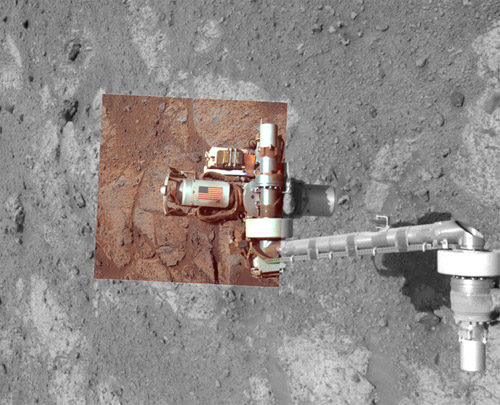The 9/11 Monument on Mars
Source: news.discovery.com

Rocks are phenomenal time keepers. Their composition, shape, and age can make an otherwise barren environment reveal its secrets.
On Mars, rocks are front and center in the ongoing quest to uncover the planet’s history and find evidence of past life. Unfortunately, we haven’t been able to send men to Mars yet; men with their built-in geology kits: eyes, hammer-wielding hands, and clever brains.
Instead, we send geology-capable surrogates in the form of rovers like Spirit and Opportunity. And in the case of these two rovers, their geologic instruments are also a tribute to the victims of the September 11 attacks on the World Trade Center.
Smashing a rock with a rover’s arm is a little dicey and potentially very problematic. So the MER team behind Spirit and Opportunity (both of which landed on Mars in 2004) came up with an easier and safer way to see inside a rock: scrape away its weathered surface. Then individual instruments -- spectrometers to determine composition, magnets to collect magnetic dust particles, and a microscopic imager for high resolution photos -- could do the science. The tool for this first step, scraping into the rocks, was the rock abrasion tool or RAT.
The small tube-shaped RAT, about the size of a soda can, was designed to grind and brush away dirt from a rock’s surface. The result was a small circular depression revealing the rock’s interior. Because the tool’s small parts were prone to clogging with dust and rock shavings, each instrument also included a wire brush to keep the “teeth” clean and maintain its cutting power. This quick fix also had the benefit of avoiding cross contaminating between different rocks.
The RATs were designed and built by Honeybee Robotics, a New York City company created and led Steve Gorevan. Founded in 1983, Honeybee got its first NASA contract in 1986. Since then, the company has worked on over 100 NASA projects with nearly all the the agency’s centers -- fitting since Gorevan pursued engineering because of a childhood desire to work for NASA.

Opportunity’s rock abrasion tool at the end of her robotic arm
But Gorevean isn’t just clever about engineering, he’s also clever about his health and fitness. In 2001, though he lived just blocks away from Honeybee’s Manhattan offices, he biked to work along a circuitous route that took him through the plaza at the World Trade Center.
On the morning of Sept. 11, he heard jet engines on his ride. Not the sound of a regular approach to LaGuardia or JFK Airports, either, but the out-of place sound of engines accelerating and flying too low to the ground. Then he heard a crash. He stopped and got off his bike. Standing in the street with a dozen or so others, he stared at the flames spewing out of the North tower. After a minute, he hopped back on his bike and pedaled the mile north to Honeybee.
Honeybee employees watched the morning’s events unfold from their building’s rooftop. They saw the towers fall and watched as masses migrated away from the site, ghostlike from a layer of soot. But work at Honeybee couldn’t stop; employees couldn’t put their work on hold to help the city recover. They had to go to Mars.
Steve Kondos, the JPL engineer in charge of the Honeybee RAT contract, came up with the way for the New York company to honor the victims: include material from the wreckage of the World Trade Center on the rovers. A lasting tribute on Spirit and Opportunity from the whole MER team.
Rather than having a Honeybee employee walk over to a fire station and ask for a piece of metal, the idea went through formal channels all the way to mayor Rudy Giuliani who approved the idea. Less than three months later, a representative from the mayor’s office arrived at Honeybee’s building with a box. It contained debris from both towers: a steel bracket, two large bolts, and a twisted plate of aluminum. The acrid smell that had permeated the city after the attacks was also preserved in that small box.
Among the pieces of debris, the aluminum plate stood out. The RATs had a lot of aluminum parts, including cable shields designed to protect the electric cables that ran the instrument from possible damage if it bumped into a rock. The aluminum from the World Trade Center was the perfect piece to cut and shape into cable shields.
Honeybee made four -- two for the flight rovers and two as spares -- and vacuum sealed an American flag on each to ensure they wouldn’t peel off.
The two cable shield monuments of the September 11 attacks, whose flags show up beautifully in the rovers’ color pictures, are still there (though looking a little dust covered in recent photos). And they should endure for millennia.
Article from: discovery.com
RATs and Monuments on Mars
Disclose.tv - Why NASA has a 9-11 memorial on MARS?
Tune into Red Ice Radio:
George J. Haas & William R. Saunders - The Martian Codex
Santos Bonacci - Hour 1 - The Holy Science
Alfred Webre - Mars and Moon Bases, Time Travel, Teleportation, Aliens & Genetic Alteration
Alfred Webre - Exopolitics, NASA Bombing of the Moon, Outer Space Treaty & E.T.
Peter Levenda - Secret Space Program & NASA’s Nazis
Ted Twietmeyer - What NASA isn’t Telling you about Mars
Mike Bara - Dark Mission, The Occult NASA Moon Mission
Richard Dolan - The Secret Space Program & Breakaway Civilization
Peter Levenda - Freemasonry, the Elite & Leaders above the Law






















